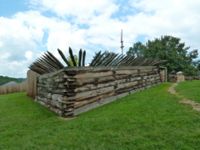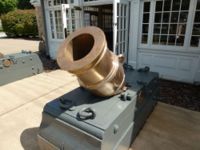Fort Ligonier: Difference between revisions
John Stanton (talk | contribs) No edit summary |
Bill Thayer (talk | contribs) m Text replace - "== ReplaceText History ==" to "== History ==" |
||
| (33 intermediate revisions by one other user not shown) | |||
| Line 1: | Line 1: | ||
{{SocialNetworks}} | {{SocialNetworks}} | ||
'''{{PAGENAME}}''' (1758-1766) - First established in 1758 by British forces under Scottish | {{PageHeader}} | ||
'''{{PAGENAME}}''' (1758-1766) - First established in 1758 by British forces under Scottish Brigadier General [[John Forbes]] during the [[French & Indian War]]. Named after British Field Marshal [[John Ligonier]], commander in chief of land forces in Great Britain. Decommissioned and abandoned in 1766. | |||
{|width="795px" cellpadding="5px" | {|width="795px" cellpadding="5px" | ||
|- valign="top" | |- valign="top" | ||
| Line 8: | Line 9: | ||
|colspan="2"|[[Image:Fort Ligonier - 118.jpg|795px|thumb|center|Fort Ligonier]] | |colspan="2"|[[Image:Fort Ligonier - 118.jpg|795px|thumb|center|Fort Ligonier]] | ||
|} | |} | ||
== | == History == | ||
Fort Ligonier was established at the western end of the Forbes Road as a part of the supply route for the attack on the French at [[Fort Duquesne]]. It was the last and biggest fort along this road and served as a base of operations against Fort Duquesne. | Fort Ligonier was established at the western end of the [[:Category:Forbes Road|Forbes Road]] as a part of the supply route for the attack on the French at [[Fort Duquesne (1)]]. It was the last and biggest fort along this road and served as a base of operations against Fort Duquesne. Colonel [[George Washington]] joined the garrison in October 1758 and participated in the advance on Fort Duquesne in November. Fort Duquesne was abandoned and blown up by the French before the British arrived on 24 Nov 1758. General Forbes arrived at the remains of [[Fort Duquesne (1)]], renamed the site Pittsburgh and began construction of [[Fort Pitt (1)]]. | ||
Fort Ligonier continued to serve as a supply post and communications element throughout the [[French & Indian War]]. The post was directly attacked twice during Pontiac's War and served as an important link until it was decommissioned on 20 Mar 1766. | Fort Ligonier continued to serve as a supply post and communications element throughout the [[French & Indian War]]. The post was directly attacked twice during [[Pontiac's War]] and served as an important link until it was decommissioned on 20 Mar 1766. | ||
[[Image:Fort Ligonier - 050.jpg|thumb|left|200px|Fort Ligonier Bastion]] | [[Image:Fort Ligonier - 050.jpg|thumb|left|200px|Fort Ligonier Bastion]] | ||
The fort was a multi-level fortification with a 200-foot square stockade with four bastions at the upper level. The stockade contained Officers' quarters, Officers' mess, a powder magazine, armory and two barracks. The stockade was ringed by an outer fortification that contained two fascine artillery batteries, officer's houses and General Forbes hut. This outer defense was built of logs, earth and topped with wooden portable defenses called chevaux de frise. | The fort was a multi-level fortification with a 200-foot square stockade with four bastions at the upper level. The stockade contained Officers' quarters, Officers' mess, a powder magazine, armory and two barracks. The stockade was ringed by an outer fortification that contained two fascine artillery batteries, officer's houses and General Forbes hut. This outer defense was built of logs, earth and topped with wooden portable defenses called chevaux de frise. | ||
| Line 25: | Line 26: | ||
{| | {| | ||
| | | | ||
<googlemap version="0.9" lat="40.240677" lon="-79.237669" zoom="17" width="500" scale="yes" overview="yes" controls="large" icons="http://www.fortwiki.com/mapicons/icon{label}.png"> | <googlemap version="0.9" lat="40.240677" lon="-79.237669" zoom="17" width="-500" height="-500" scale="yes" overview="yes" controls="large" icons="http://www.fortwiki.com/mapicons/icon{label}.png"> | ||
(F) 40.240833, -79.237778 | (F) 40.240833, -79.237778 | ||
Fort Ligonier<br>(1758-1766) | Fort Ligonier<br>(1758-1766) | ||
</googlemap> | </googlemap> | ||
|valign="top"| | |valign="top"| | ||
'''Location:''' Westmoreland County, Pennsylvania. | '''Location:''' Ligonier, Westmoreland County, Pennsylvania. | ||
{{Mapit-US-cityscale|40.240833|-79.237778}} | {{Mapit-US-cityscale|40.240833|-79.237778}} | ||
* Elevation: ' | * Elevation: 1,201' | ||
|} | |} | ||
'''Recent Blog Posts:''' | |||
* [http://usforting.com/2011/03/15/fort-ligonier-pennsylvania/ Fort Ligonier, Pennsylvania] | |||
'''Sources:''' | '''Sources:''' | ||
* {{Roberts}}, page 685 | * {{Roberts}}, page 685 | ||
* West, Martin, ''Fort Ligonier: Official Guidebook & Map'', Fort Ligonier Association, Knepper Press, Pittsburgh, 2009, ISBN 978-0-615-28712-6 | |||
'''Links:''' | '''Links:''' | ||
* [http://www.northamericanforts.com/East/pa-west.html#ligonier North American Forts - Fort Ligonier] | * [http://www.northamericanforts.com/East/pa-west.html#ligonier North American Forts - Fort Ligonier] | ||
* [http://en.wikipedia.org/wiki/Fort_Ligonier Wikipedia - Fort Ligonier] | |||
* [http://en.wikipedia.org/wiki/Forbes_Road Wikipedia - Forbes Road] | |||
* [http://fortligonier.org/ Official Fort Site] | |||
* [http://www.ligonier.com/history.html Ligonier Town History] | |||
{{Visited|26 Aug 2010}} | {{Visited|26 Aug 2010}} | ||
| Line 48: | Line 55: | ||
<gallery> | <gallery> | ||
Image:Fort Ligonier - 008.jpg|Fort Ligonier Howitzer | Image:Fort Ligonier - 008.jpg|Fort Ligonier Howitzer | ||
Image:Fort Ligonier - 035.jpg|Fort Ligonier Pit Mortar | |||
Image:Fort Ligonier Mortar - 2.jpg|Fort Ligonier Mortar and Block Carriage | |||
Image:Fort Ligonier Mortar - 3.jpg|Fort Ligonier Mortars | |||
Image:Fort Ligonier - 028.jpg|Fort Ligonier Defenses | |||
Image:Fort Ligonier Magazine.jpg|Fort Ligonier Powder Magazine | |||
Image:Fort Ligonier - 043.jpg|Fort Ligonier Bastion Interior | |||
Image:Fort Ligonier - 088.jpg|Fort Ligonier Officer's Mess | |||
Image:Fort Ligonier - 086.jpg|Fort Ligonier Stockade Gate | |||
Image:Fort Ligonier - 020.jpg|Fort Ligonier Bake Ovens | |||
</gallery> | </gallery> | ||
__NOTOC__ | __NOTOC__ | ||
{{PageFooter}} | |||
{{DEFAULTSORT:Ligonier}} | {{DEFAULTSORT:Ligonier}} | ||
[[Category:All]] | [[Category:All]] | ||
| Line 60: | Line 76: | ||
[[Category:{{PAGENAME}}]] | [[Category:{{PAGENAME}}]] | ||
[[Category:Colonial Forts]] | [[Category:Colonial Forts]] | ||
[[Category:French | [[Category:French & Indian War Forts]] | ||
[[Category:Forbes Road]] | |||
[[Category:Starter Page]] | [[Category:Starter Page]] | ||
[[Category:2010 Northern Trip]] | [[Category:2010 Northern Trip]] | ||
[[Category:Reconstructed]] | [[Category:Reconstructed]] | ||
[[Category:Display Gun]] | |||
[[Category:Must See]] | [[Category:Must See]] | ||
Latest revision as of 06:08, 23 September 2021
|
Fort Ligonier (1758-1766) - First established in 1758 by British forces under Scottish Brigadier General John Forbes during the French & Indian War. Named after British Field Marshal John Ligonier, commander in chief of land forces in Great Britain. Decommissioned and abandoned in 1766.
HistoryFort Ligonier was established at the western end of the Forbes Road as a part of the supply route for the attack on the French at Fort Duquesne (1). It was the last and biggest fort along this road and served as a base of operations against Fort Duquesne. Colonel George Washington joined the garrison in October 1758 and participated in the advance on Fort Duquesne in November. Fort Duquesne was abandoned and blown up by the French before the British arrived on 24 Nov 1758. General Forbes arrived at the remains of Fort Duquesne (1), renamed the site Pittsburgh and began construction of Fort Pitt (1). Fort Ligonier continued to serve as a supply post and communications element throughout the French & Indian War. The post was directly attacked twice during Pontiac's War and served as an important link until it was decommissioned on 20 Mar 1766.  The fort was a multi-level fortification with a 200-foot square stockade with four bastions at the upper level. The stockade contained Officers' quarters, Officers' mess, a powder magazine, armory and two barracks. The stockade was ringed by an outer fortification that contained two fascine artillery batteries, officer's houses and General Forbes hut. This outer defense was built of logs, earth and topped with wooden portable defenses called chevaux de frise. Outside the fortifications were a number of support facilities including the hospital, blacksmith shops, cooking facilities and transport support area.
Current Status The fort has been reconstructed by a private foundation with all private funding. The reconstruction is an ongoing project begun in 1954 and includes a magnificent museum. One of the most impressive aspects of the recreation is the number of bright brass replica cannons and mortars scattered about the fort. All kinds of artillery are represented and the displays include great replicas of the carriages and limbers. The Museum is located at 200 South Market Street and should not be missed; it contains a collection of artifacts and portraits that are seldom seen in fort museums.
Recent Blog Posts: Sources:
Links:
Visited: 26 Aug 2010 Fort Ligonier Picture Gallery
| |||||||












